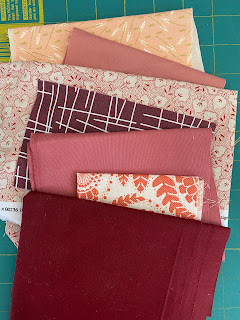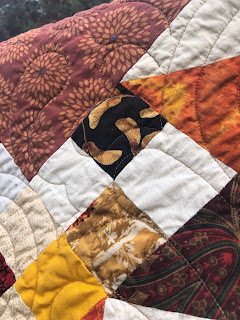I don’t know about your stash, but I have loads of strings and off cuts that I need to use. I figured making a foundation pieced block would be the best way to use up some of those fabrics. I like the idea of a scrappy look with intention, so for this month you’ll need to dig through your scraps and pick with intention.
To start you will need to cut four 6.5 inch blocks from any gray print fabric, warm grays and cool grays are fine, just start with gray.
Then you will need to sort your strings by color. Please use fabrics that read as the color. For instance, if the print is small on a white background, it may read more white than color. A good way to determine is to step back a foot or two and see what color the fabric reads. Also (I know I am preaching to the choir) be sure to vary the width of your strings. Each block will have strings of a same/similar color.
So with your strings sorted into four color groups, you’re ready to sew.
First draw a diagonal line corner to corner on the wrong side of your gray 6.5 inch squares. You may also use diagonal seam tape or fold and press a line. This will be used as a reference point for aligning your first string. Align your longest and first string right sides together on your gray square. Sew a ¼ inch seam along the diagonal. I used a pin to pin my first string and flipped my block and sewed along my drawn line. For most of my blocks, my ¼ inch seam was quite generous. Fold string and press open, and then use your first string as your guide to line up your next string. Continue adding strings until half of your 6.5 inch gray square is covered.
Once
you’ve finished adding your strings, flip your block over and using your gray square as your guide, trim off the hanging strings. You will repeat the process and make 4 total 6.5 string blocks.
You do not need to worry about squaring your blocks, I will take care of that. My ultimate plan is to sort the squares by color and make a ROY-G-BIV/rainbow layout.
I am so excited to receive your blocks and lay out this quilt.
XOXO
Deanna













.HEIC)
.HEIC)
.HEIC)
.heic)


































